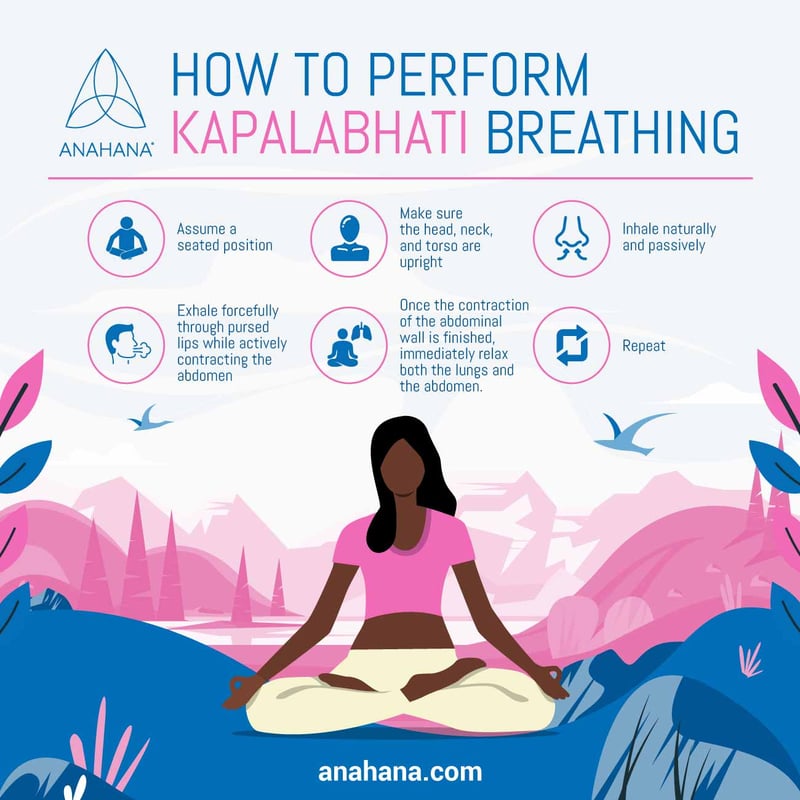
Table of Contents
Kapalabhati breathing, or the breath of fire, is a cleansing technique meant to bring the body back to proper homeostasis through yogic breathing.
All this can be achieved by practicing this technique on a regular basis.
It’s characterized by forcing the air out with abdominal muscles, then immediately relaxing the diaphragm and abdomen to pull air back in passively.
Understanding Kapalabhati Basics
Kapalabhati breathing, or the “breath of fire,” is a rapid breathing technique from the longstanding discipline of pranayama yoga.
It is often described as energizing, cleansing and heating. This breathing exercise has very little risk, bar those with pre-existing cardiovascular conditions and injuries.
Spiritually, Kapalabhati pranayama can help purify various energies. Medical research shows similar results, proving it is effective in various conditions, especially modernization-related ones.
Benefits of Kapalabhati Breathing
Kapalabhati comes from kapala, meaning “skull and the organs inside it,” and bhati, “illuminating.”
Some claim it comes from the refreshing feeling that remains when complete. Some claim its purification capabilities; some even claim that regular practice makes the forehead shiny and the practitioner’s head more energy-luminescent.
These are the reasons why it’s called the “skull-shining breath.” Kapalabhati pranayama is prized for its health benefits. Some consider it the best technique for re-oxygenating blood, which is why some insist it helps renew body tissue and fight old age.
Physical Benefits
Physical benefits as the breath flows in Kapalabhati include:
-
Improved respiratory system health
-
Increased lung capacity
-
Improved blood circulation and oxygenation
-
Better digestion
-
Stronger abdominal and core muscles
-
Improved nervous system activity
-
Enhanced alertness and mental clarity
-
Reduced stress levels
-
Improved immunity
The main use of Kapalabhati pranayama is to maintain the homeostasis and well-being of people, and it is also considered a cure for various ailments.
The rapid breathing and the contractions of the abdomen have a pronounced effect on the abdomen and its glands. The resulting improvement in blood circulation and gland secretion correction help manage the disease.
As a result, it’s very effective in conditions that involve disrupting the autonomic nervous system, such as diabetes, hypertension (i.e. high blood pressure), and obesity.
Metaphysical and Spiritual Benefits
Spiritually, Kapalabhati breath can help purify the subtle energy streams or nadis. It assists in purifying the body of kapha (phlegm), which ultimately builds to an awakening of energies along the sushumna or the main spinal nadi.
It also balances the vata (wind), pitta (bile), and kapha. Mental and spiritual benefits include:
- Enhanced mental clarity
- Improved emotional well-being
- Deepened spiritual connection
- Heightened awareness of the body’s subtle energy
- Rejuvenation of the mind, body, and spirit
The breath of fire is often done as part of Kundalini yoga practices, which include chanting, breathing techniques, singing, and repetitive poses.
The Science Behind Kapalabhati Breathing
Abdominal breathing is slow, but the powerful contractions produce veritable waves of breath and are also known to help stabilize emotions and control responses to stressful environments.
Kapalabhati breath may be seen as a sympathetic nervous system activity, which increases alertness and attentiveness and results in better oxygenation of vital organs despite a low heart rate.
During Kapalabhati practice, oxygen consumption can be between 1.1 to 1.8 times higher than regular activity. The heart rate jumps in the first 20-40 seconds of yogic breathing but levels off to the higher side.
Hyperventilation
Although Kapalabhati pranayama is a rapid breathing exercise, it doesn’t produce hyperventilation. The lack of dizziness can prove this during properly done practice, which is a sign of hyperventilation.
The average CO2 concentrations post-yoga practice are similar to the resting state. The heart rates of practitioners of Kapalabhati are also different from those of people hyperventilating. Those predisposed to dizziness, however, are an exception.
How to Perform Kapalabhati Breathing

Kapalabhati is an advanced pranayama technique that necessitates prior knowledge of abdominal breathing. Familiarity with foundational pranayamas like Ujjayi Breathing is recommended before attempting this.
These instructions aim to offer a safe and general introduction to the practice. However, learning from a qualified instructor is always advisable. Some of the general instructions are:
-
Assuming a seated position.
-
Maintaining a strong sitting posture during the exercise is very important, especially when it gets more intense.
-
Make sure the head, neck, and torso are upright and steady.
-
Make sure the first inhale is breathing until about ¾ full through passive inhales.
-
Exhale quickly and forcefully through the nose while actively contracting the abdomen.
-
Once the contraction of the abdominal wall is finished, immediately relax both the lungs and the abdomen. That should naturally help the lungs draw in the fresh air.
-
Repeating the quick and forceful exhalation.
-
The next resulting inhale happens naturally and passively upon relaxation. It’s important to do it without much thought. Continue to repeat this cycle.
In the beginning, try going twice daily, three sets each time, about ten reps each. It’s best to pace oneself for a few rounds while giving time to recover.
Once the current program becomes comfortable, try increasing the repetitions or time in each set.
Precautions
People should not practice rapid breathing practices like Kapalabhati with eye conditions (i.e. glaucoma), ear conditions (i.e. fluid in ears), or a bleeding nose.
Those with high or low blood pressure or coronary heart disease should avoid practicing this yoga type. Those who had recent surgery on abdominal organs should also avoid the exercise.
Practice kapalabhati on an empty stomach, usually around two or more hours after eating. Keep the bladder and bowels empty while performing this technique. Immediately discontinue yoga practice if one experiences syncope, dizziness, or can’t maintain a steady rhythm.
Those predisposed to those symptoms should consult a medical professional before attempting. Most of all, keep an eye on one’s capacity. This practice will help build stamina, but the moment fatigue is detectable, end the practice.
Bear in mind this is a breathing exercise, so the first muscles to get tired are generally the respiratory muscles.
Frequently Asked Questions
How is this breathing different from pursed-lip breathing?
Pursed lip breathing is closer to regular breathing exercises than to Kapalahbati in its timing. Also, Khapalabati is strictly through the nose.
Pursed lip breathing exhales through the mouth. The purpose is also different; Kapalabhati’s is to energize and recondition the body, while pursed lip breathing is calming and a tool to reoxygenate blood quickly.
Which breathing exercise is similar to Kapalabhati breathing?
Bhastrika Pranayama is similar in action but not so in effect. It mainly benefits the nervous system, refreshing the mind and helping with depression and anxiety.
Alternate nostril breathing could have similar effects if performed with the force of the abdominal muscles, but it’s usually a calming practice often used to finish an asana practice.
What abdominal muscles engage in Kapalabhati practice?
The primary muscles in Kapalabhati practice are the diaphragm and abdominal muscles such as the rectus abdominis, the internal and external oblique muscles, and the transverse abdominis.
What can performing Kapabalbhati daily can result in?
Daily practice may improve lung capacity, digestive organs, focus, and energy levels. But overdoing it can cause dizziness or strain, especially if you have heart, blood pressure, or respiratory issues. Always start at a slow pace and gradually increase and avoid if medically advised.
References
Kapalbhati Pranayama: Breathe Your Way to Better Weight Loss | The Art of Living
Learn Kapalabhati (Skull Shining Breath)
Light Up Your Life With Kapalabhati (Benefits and Tips) • Yoga Basics
Disclaimer
The contents of this article are provided for informational purposes only and are not intended to substitute for professional medical advice, diagnosis, or treatment. It is always recommended to consult with a qualified healthcare provider before making any health-related changes or if you have any questions or concerns about your health. Anahana is not liable for any errors, omissions, or consequences that may occur from using the information provided.

By: Meriah McCauley
Meriah McCauley is a leading voice in holistic healing, known across North America for her expertise in chakra balancing, spiritual alignment, and energy-based wellness. Her work bridges the art and science of mind-body healing, shaped through years of study, practice, and mentorship. Meriah deepened her understanding of spiritual anatomy and the chakra system under the guidance of her guru, Dr. Don Stapleton, during her immersive training in Costa Rica. She later earned her Master’s degree in Psychology from Columbia University, specializing in Spirituality and the Mind–Body connection, which continues to influence her integrative approach. Today, she supports individuals and practitioners through coaching, yoga teacher trainings, chakra-focused education, and Holotropic Breathwork for personal transformation. Meriah is dedicated to helping others develop emotional clarity, energetic balance, and spiritual resilience—and she remains committed to guiding anyone seeking a deeper, more meaningful connection with themselves.